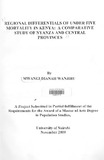Regional differentials of under five mortality in Kenya: a comparative study of Nyanza and Central provinces
| dc.contributor.author | Mwangi, Dianah W | |
| dc.date.accessioned | 2012-11-13T12:36:11Z | |
| dc.date.available | 2012-11-13T12:36:11Z | |
| dc.date.issued | 2009 | |
| dc.identifier.uri | http://erepository.uonbi.ac.ke:8080/handle/123456789/5327 | |
| dc.description.abstract | The study aimed at carrymg out a comparative analysis of the deteterminants of under- 5 mortality in Central and Nyanza Provinces. Data was obtained from the KDHS 2003. Children born during 5 years preceding the study who were the outcomes of singleton deliveries and who either survived the childhood period or not formed the universe of this study. Cox proportional hazard model was used in the analysis of this data. This method was chosen since it is ideal for modelling time -to -event data in the presence of censored cases. Results of the proportional hazard models revealed that only birth interval was a significant determinant of under-5 mortality in both Central and Nyanza Provinces though maternal education and maternal age at birth exhibited weak association in Nyanza Province. The study recommends that there is need for enhancement of women education in Nyanza province and emphasis need to be put on the issue of unmet needs of family planning in both regions where birth interval has come out as a strong factor influencing under-5 mortality in both regions. The study also recommends that further research needs to be done in order to establish the behavioral factors that could be influencing child mortality in Nyanza and the contribution of diseases like malaria to child mortality in that Province. | en_US |
| dc.language.iso | en_US | en_US |
| dc.publisher | University of Nairobi, Kenya | en_US |
| dc.title | Regional differentials of under five mortality in Kenya: a comparative study of Nyanza and Central provinces | en_US |
| dc.title.alternative | Thesis (MA) | en_US |
| dc.type | Thesis | en_US |

